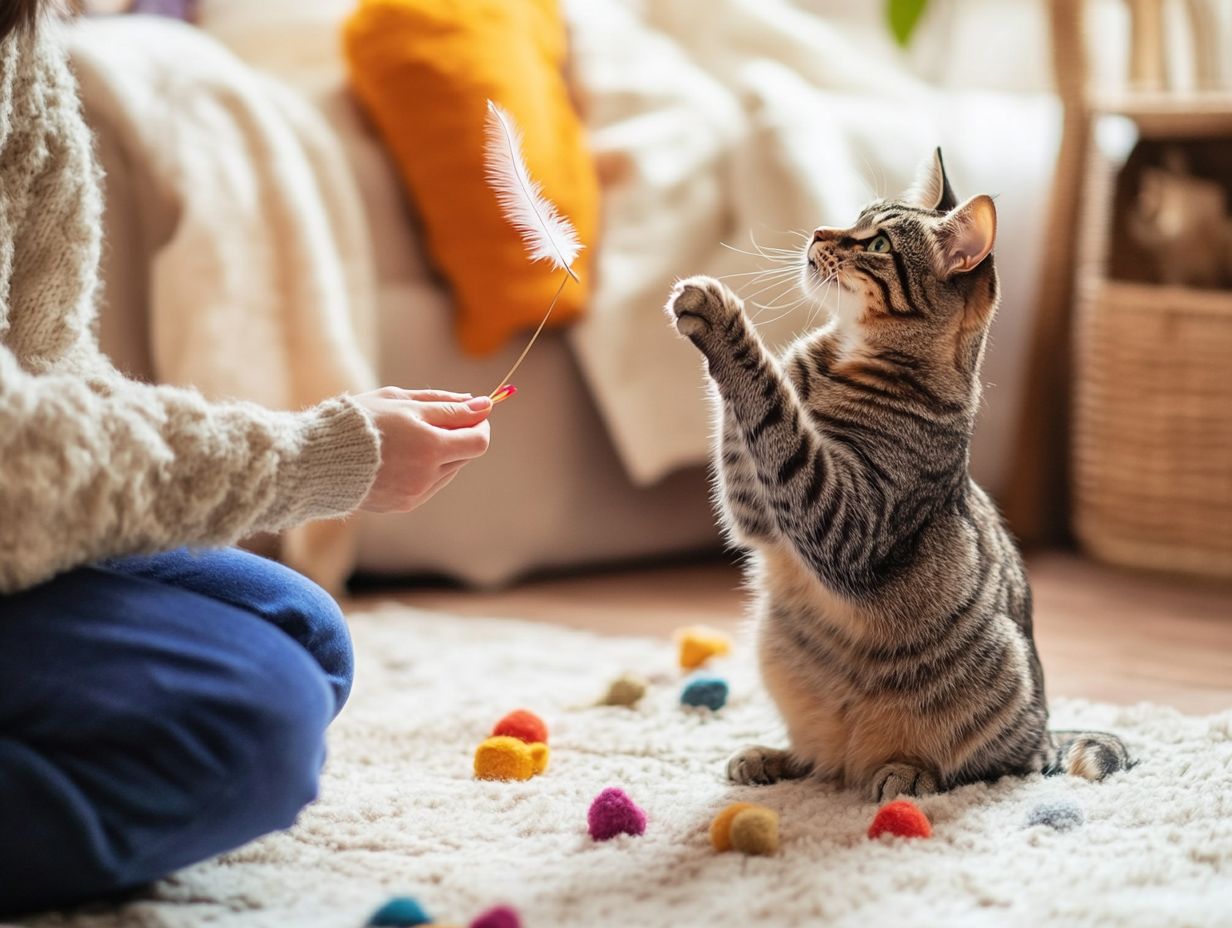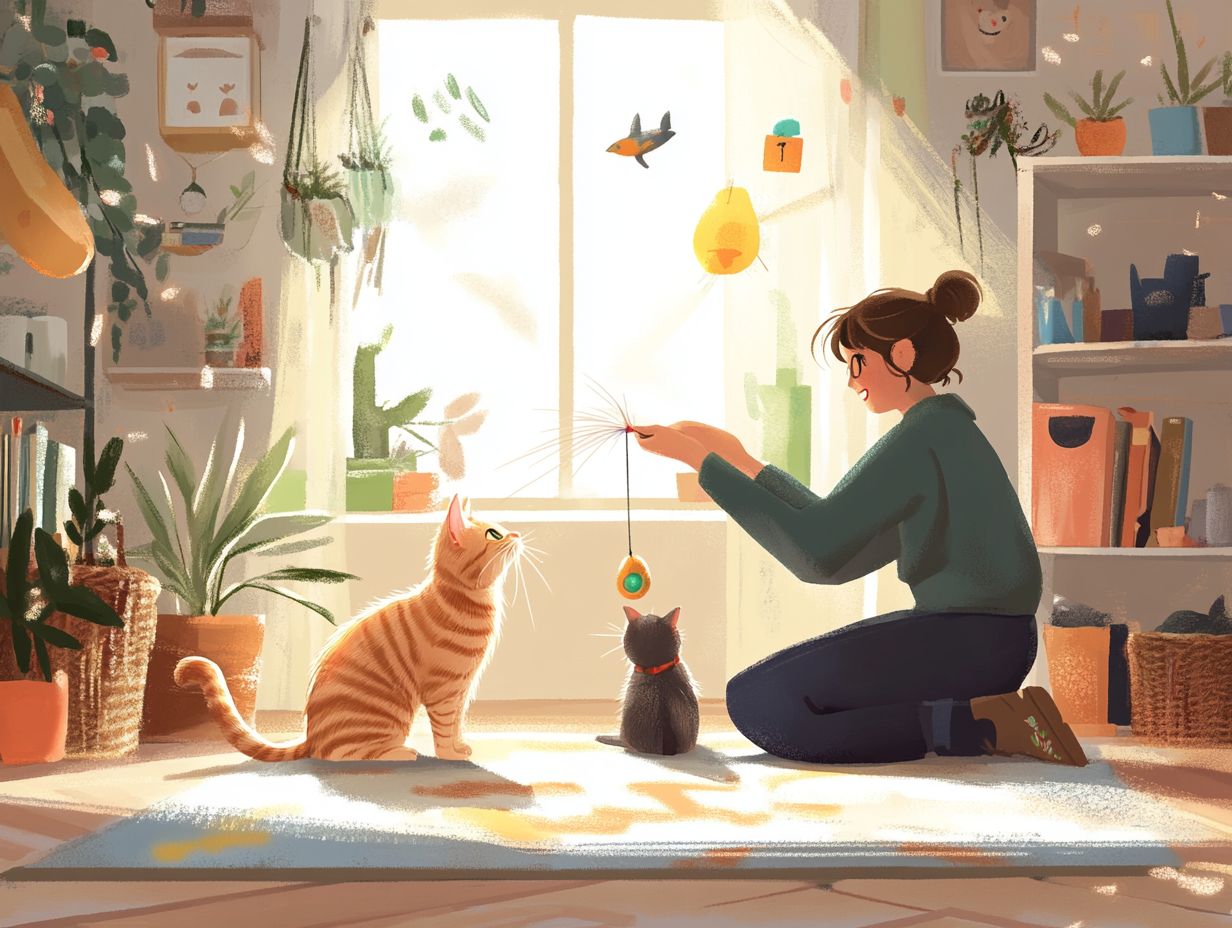The Role of a Cat Whisperer

A cat whisperer is someone who possesses a deep understanding of complex feline behavior and communication, enabling cat owners to strengthen their bond with their pets.
By carefully observing body language and behavior, a cat whisperer can facilitate positive interactions and nurture desirable behaviors, ultimately enhancing the human-animal connection.
The communication strategies employed in animal whispering offer valuable insights into feline psychology and instincts, enriching cat owners’ understanding of their pets’ needs and emotions.
Understanding Your Cat’s Behavior
Understanding cat behavior is essential for successful training, as it involves recognizing the unique instincts and body language of felines. By acknowledging behavioral signals, you can enhance your interactions with your pet and gain insight into their needs, feelings, and any stress or anxiety they may be experiencing.
This knowledge is particularly important when determining whether a vet visit is necessary. A deeper comprehension of cat behavior also enables owners to make informed decisions regarding their cat’s diet and environmental enrichment. A balanced diet tailored to specific health needs significantly impacts a cat’s mood and energy levels.
Additionally, providing stimulating toys and engaging playtime can help alleviate boredom and reduce unwanted behaviors. By understanding how a cat responds to various stimuli, including food types, play activities, and living environments, owners can create a supportive atmosphere that promotes their cat’s overall well-being.
Training Techniques for Cats
Training techniques for cats are crucial for instilling obedience and encouraging desired behaviors, particularly through positive reinforcement.
Using reward-based training methods and having a proper understanding of feline temperament can help impart essential skills to your pet. This approach not only strengthens your bond with your cat but also contributes to a stable home environment.
Positive Reinforcement vs. Punishment

The positive effects of using positive reinforcement in cat training are numerous:
- Positive reinforcement is more effective than punishment: This training philosophy is more successful than punishment. While punishment can instill fear and anxiety in cats, positive reinforcement fosters trust and security between the animal and its owner.
- Positive reinforcement builds bonds: By focusing on praise and rewards, positive reinforcement strengthens the bond between the owner and the cat. This approach allows owners and their feline companions to establish a deeper, more trusting relationship.
- Positive reinforcement promotes emotional stability: As trust is built through positive reinforcement, cats thrive in a safe environment that fosters emotional stability. Rather than being on guard against punishment, a well-behaved cat learns that good behavior is rewarded.
- Positive reinforcement encourages engagement: Unlike punishment, which can introduce stress and trigger previously learned negative behaviors, reward-based training promotes ongoing engagement and motivation. This makes it easier for pet owners to address behavioral issues effectively.
- Positive reinforcement results in a happier, balanced cat: Ultimately, building a relationship based on trust and security through positive reinforcement leads to a happier, more balanced cat. This approach results in significant improvements in feline behavior and emotional well-being.
Effective Communication with Cats
Cats communicate through their unique behaviors, body language, and vocalizations, which include meowing, purring, growling, hissing, chattering, and yowling. These vocalizations serve as a means of communication not only between owners and their pet cats but also among cats themselves, expressing a variety of emotions and needs.
Learning to communicate effectively with cats can strengthen the bond between them and their owners while improving their overall well-being. Understanding the nuances of their communication helps cat owners respond appropriately to their pets’ signals, whether the cat is happy, sad, comfortable, in pain, or stressed.
Recognizing signs of stress is an important communication skill, as cats may exhibit changes in behavior or body posture during anxious moments. Play is a vital aspect of cat communication; interactive play provides mental stimulation, enriches the environment, and fosters socialization between the cat and its owner.
Positive social behaviors between owners and their cats can be encouraged through regular interactive play. Additionally, enriching the environment with stimulating toys and varying play routines can help reduce boredom and anxiety in cats. Understanding these forms of communication and social behavior is essential for developing a positive relationship with a cat.
Common Behavioral Issues in Cats
Common behavioral issues in cats, including aggression, scratching, and litter box problems, can often be addressed by understanding feline habits and instincts.
By identifying the root causes of these behaviors, cat owners can implement effective training methods that promote positive interactions and reduce stress for their cats.
Addressing Aggression, Scratching, and Litter Box Problems

You can address aggression, scratching, and litter box issues in cats by understanding their behavioral characteristics, observing their actions, recognizing environmental factors, and employing effective training techniques. This is crucial because the most common reasons cats exhibit these problematic behaviors are often related to anxiety, stress, or insufficient stimulation.
For example, providing engaging toys and climbing structures can help alleviate frustration in bored cats, thereby reducing the likelihood of aggression toward owners or other pets. Since cats are creatures of habit, establishing a routine can foster a sense of security, which may lessen their anxiety and contribute to a decrease in aggressive behavior.
If a cat’s behavioral problems are beyond an owner’s control, such as those caused by other aggressive animals or pets in the household, it is advisable to seek the guidance of a veterinarian or animal behaviorist.
Training techniques like positive reinforcement and redirecting unwanted behaviors can be effective in managing scratching and litter box issues. By closely monitoring and modifying their cat’s environment, owners can ensure a happier and healthier pet, strengthening their bond in the process.
Building a Strong Bond with Your Cat
Building a strong bond with your cat is vital for both their emotional well-being and your relationship. This connection can be fostered through various bonding activities and an understanding of your cat’s needs.
Engaging in interactive play, employing proper grooming techniques, and recognizing your cat’s unique personality traits all contribute to building trust. These efforts are essential for ensuring your cat’s happiness and overall health.
Tips for Strengthening Your Relationship with Your Feline Friend
The best ways to strengthen your relationship with a cat involve spending time together each day and engaging in bonding activities, such as interactive play and rewarding them with treats or toys for good behavior. These interactions help you better understand your pet’s needs and feelings.
Daily activities that can enhance your bond with your cat include establishing a routine that aligns with their natural behaviors and instincts. For instance, providing a high cat tree for them to jump on or hiding their food in various places around the house encourages exploration.
Research indicates that incorporating play that simulates hunting not only satisfies a cat’s instinct to hunt but also offers vital mental stimulation. Additionally, spending quiet time together, along with petting or brushing your cat, fosters trust and reduces stress, which is especially beneficial for rescue or nervous cats.
As you spend quality time together, you’ll naturally become more attuned to your cat’s preferences and habits. For example, you may discover that your cat enjoys being petted for only a few seconds on their head or neck rather than for an extended period. You’ll also become adept at recognizing the different sounds your cat makes, as well as the body language and behaviors they display, which indicate their current emotional state.
The Benefits of Cat Training

The benefits of cat training extend beyond merely ensuring obedience. Training can significantly enhance a cat’s quality of life, as well as its overall health and well-being.
Utilizing effective techniques, such as positive reinforcement, can help address behavioral issues while also enriching your cat’s life.
Improving Your Cat’s Quality of Life
Enhancing your cat’s quality of life involves employing proper training techniques, enriching their environment, and engaging in interactive play that stimulates both their mind and body. By recognizing and addressing your cat’s diverse needs, you can help them enjoy a more fulfilling and happier existence.
Engaging a cat’s natural instincts is essential, as they thrive in settings that challenge their minds and offer opportunities for physical activity. Interactive toys, such as feather wands and laser pointers, encourage predatory behavior while reducing stress and preventing boredom.
Puzzle feeders also offer an effective means of mental stimulation, transforming feeding time into an enjoyable activity. Dedicating time each day to play with your cat strengthens the bond between you and your pet, fostering an atmosphere of trust and happiness.
Additionally, providing a stimulating environment with climbing structures and cozy hideouts can further enhance your cat’s quality of life, ensuring they remain happy and fulfilled.
Creating a Harmonious Home Environment
A harmonious home for cats fosters positive social interaction, environmental enrichment, and effective training techniques. This environment promotes social contact, mental stimulation, and a safe space that supports the expression of their needs and feelings.
A well-balanced atmosphere can significantly enhance a cat’s quality of life, allowing them to showcase their unique personalities and preferences so that their guardians can observe and respond accordingly.
Dedicated areas that provide vertical space, interactive toys, and soft resting spots create a stress-free environment, enabling cats to explore and relax at their leisure.
Regular playtime and gentle interactions between you and your cat help strengthen your bond while encouraging healthy socialization, which is essential for mental stimulation. This nurturing approach fosters a sense of safety and contentment, ultimately contributing to a positive emotional state, resulting in a happier cat that is more resilient to stressors.
